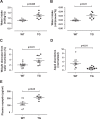Coordinated Regulation of Vasopressin Inactivation and Glucose Uptake by Action of TUG Protein in Muscle
- PMID: 25944897
- PMCID: PMC4505512
- DOI: 10.1074/jbc.C115.639203
Coordinated Regulation of Vasopressin Inactivation and Glucose Uptake by Action of TUG Protein in Muscle
Abstract
In adipose and muscle cells, insulin stimulates the exocytic translocation of vesicles containing GLUT4, a glucose transporter, and insulin-regulated aminopeptidase (IRAP), a transmembrane aminopeptidase. A substrate of IRAP is vasopressin, which controls water homeostasis. The physiological importance of IRAP translocation to inactivate vasopressin remains uncertain. We previously showed that in skeletal muscle, insulin stimulates proteolytic processing of the GLUT4 retention protein, TUG, to promote GLUT4 translocation and glucose uptake. Here we show that TUG proteolysis also controls IRAP targeting and regulates vasopressin action in vivo. Transgenic mice with constitutive TUG proteolysis in muscle consumed much more water than wild-type control mice. The transgenic mice lost more body weight during water restriction, and the abundance of renal AQP2 water channels was reduced, implying that vasopressin activity is decreased. To compensate for accelerated vasopressin degradation, vasopressin secretion was increased, as assessed by the cosecreted protein copeptin. IRAP abundance was increased in T-tubule fractions of fasting transgenic mice, when compared with controls. Recombinant IRAP bound to TUG, and this interaction was mapped to a short peptide in IRAP that was previously shown to be critical for GLUT4 intracellular retention. In cultured 3T3-L1 adipocytes, IRAP was present in TUG-bound membranes and was released by insulin stimulation. Together with previous results, these data support a model in which TUG controls vesicle translocation by interacting with IRAP as well as GLUT4. Furthermore, the effect of IRAP to reduce vasopressin activity is a physiologically important consequence of vesicle translocation, which is coordinated with the stimulation of glucose uptake.
Keywords: aminopeptidase; glucose transporter type 4 (GLUT4); insulin; membrane trafficking; skeletal muscle; translocation; vasopressin.
© 2015 by The American Society for Biochemistry and Molecular Biology, Inc.
Figures


Similar articles
-
Usp25m protease regulates ubiquitin-like processing of TUG proteins to control GLUT4 glucose transporter translocation in adipocytes.J Biol Chem. 2018 Jul 6;293(27):10466-10486. doi: 10.1074/jbc.RA118.003021. Epub 2018 May 17. J Biol Chem. 2018. PMID: 29773651 Free PMC article.
-
Acetylation of TUG protein promotes the accumulation of GLUT4 glucose transporters in an insulin-responsive intracellular compartment.J Biol Chem. 2015 Feb 13;290(7):4447-63. doi: 10.1074/jbc.M114.603977. Epub 2015 Jan 5. J Biol Chem. 2015. PMID: 25561724 Free PMC article.
-
Enhanced fasting glucose turnover in mice with disrupted action of TUG protein in skeletal muscle.J Biol Chem. 2013 Jul 12;288(28):20135-50. doi: 10.1074/jbc.M113.458075. Epub 2013 Jun 6. J Biol Chem. 2013. PMID: 23744065 Free PMC article.
-
Vasopressin inactivation: Role of insulin-regulated aminopeptidase.Vitam Horm. 2020;113:101-128. doi: 10.1016/bs.vh.2019.08.017. Epub 2019 Oct 18. Vitam Horm. 2020. PMID: 32138946 Review.
-
A proteolytic pathway that controls glucose uptake in fat and muscle.Rev Endocr Metab Disord. 2014 Mar;15(1):55-66. doi: 10.1007/s11154-013-9276-2. Rev Endocr Metab Disord. 2014. PMID: 24114239 Free PMC article. Review.
Cited by
-
Ubiquitin-like processing of TUG proteins as a mechanism to regulate glucose uptake and energy metabolism in fat and muscle.Front Endocrinol (Lausanne). 2022 Sep 29;13:1019405. doi: 10.3389/fendo.2022.1019405. eCollection 2022. Front Endocrinol (Lausanne). 2022. PMID: 36246906 Free PMC article. Review.
-
GLUT4 Trafficking and Storage Vesicles: Molecular Architecture, Regulatory Networks, and Their Disruption in Insulin Resistance.Int J Mol Sci. 2025 Aug 5;26(15):7568. doi: 10.3390/ijms26157568. Int J Mol Sci. 2025. PMID: 40806697 Free PMC article. Review.
-
Insulin-stimulated endoproteolytic TUG cleavage links energy expenditure with glucose uptake.Nat Metab. 2021 Mar;3(3):378-393. doi: 10.1038/s42255-021-00359-x. Epub 2021 Mar 8. Nat Metab. 2021. PMID: 33686286 Free PMC article.
-
GLUT4 Storage Vesicles: Specialized Organelles for Regulated Trafficking.Yale J Biol Med. 2019 Sep 20;92(3):453-470. eCollection 2019 Sep. Yale J Biol Med. 2019. PMID: 31543708 Free PMC article. Review.
-
Usp25m protease regulates ubiquitin-like processing of TUG proteins to control GLUT4 glucose transporter translocation in adipocytes.J Biol Chem. 2018 Jul 6;293(27):10466-10486. doi: 10.1074/jbc.RA118.003021. Epub 2018 May 17. J Biol Chem. 2018. PMID: 29773651 Free PMC article.
References
-
- Bogan J. S. (2012) Regulation of glucose transporter translocation in health and diabetes. Annu. Rev. Biochem. 81, 507–532 - PubMed
-
- Bogan J. S., Hendon N., McKee A. E., Tsao T. S., Lodish H. F. (2003) Functional cloning of TUG as a regulator of GLUT4 glucose transporter trafficking. Nature 425, 727–733 - PubMed
Publication types
MeSH terms
Substances
Grants and funding
- R01DK092661/DK/NIDDK NIH HHS/United States
- R01 DK092661/DK/NIDDK NIH HHS/United States
- T32DK007058/DK/NIDDK NIH HHS/United States
- F30 DK093198/DK/NIDDK NIH HHS/United States
- P30 DK079310/DK/NIDDK NIH HHS/United States
- P30 DK45735/DK/NIDDK NIH HHS/United States
- I01 BX000901/BX/BLRD VA/United States
- U24 DK059635/DK/NIDDK NIH HHS/United States
- T32 DK007058/DK/NIDDK NIH HHS/United States
- P30DK079310/DK/NIDDK NIH HHS/United States
- R21AG041383/AG/NIA NIH HHS/United States
- P30 DK045735/DK/NIDDK NIH HHS/United States
- R21 AG041383/AG/NIA NIH HHS/United States
- T32 GM007205/GM/NIGMS NIH HHS/United States
- I01 BX000702/BX/BLRD VA/United States
- F30DK093198/DK/NIDDK NIH HHS/United States
LinkOut - more resources
Full Text Sources
Molecular Biology Databases

